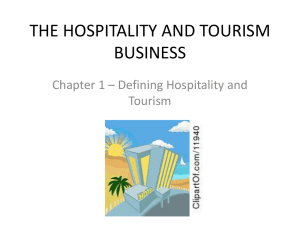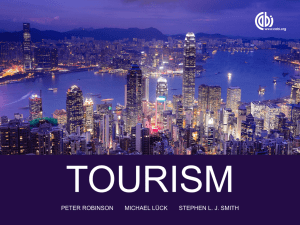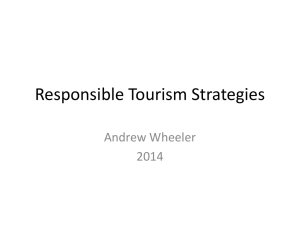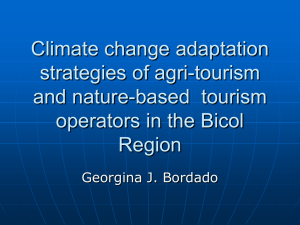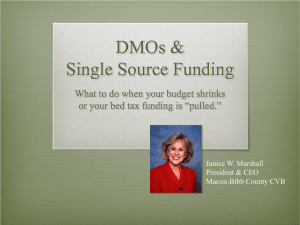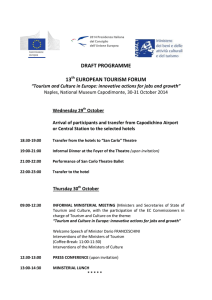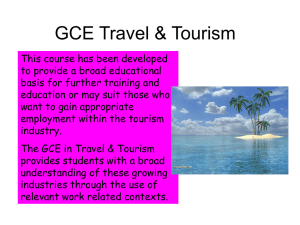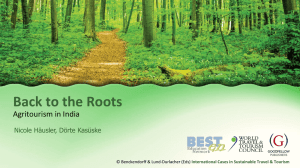regeneration strategy for the ga-rankuwa hotel school
advertisement
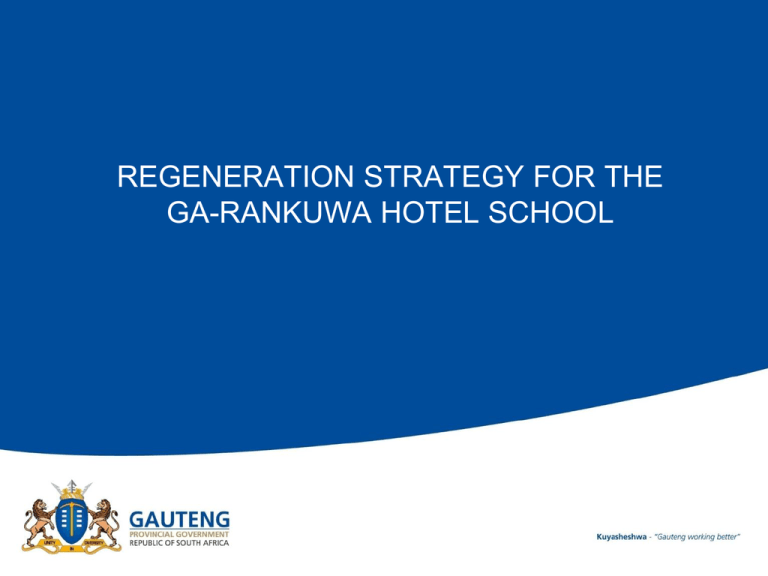
REGENERATION STRATEGY FOR THE GA-RANKUWA HOTEL SCHOOL Contents 1. 2. 3. 4. 5. 6. Introduction Policy and Strategy context Situation Analysis, Physical Facilities and Key Issues Training in the tourism sector Skills Gaps Best practices – hotel schools and related physical facilities 7. Regeneration Strategy 8. Marketing Plan 9. Financial Model 10. Implementation Roadmap 11. DED Vision 12. Conclusions Introduction Background • The Ga-Rankuwa Hotel School (GRHS), located in Ga-Rankuwa township of the Gauteng Province, is currently a campus of the hotel division of the North West Parks and Tourism Board (NWPTB) and is in the process of being transferred to Department of Economic Development of the Gauteng Provincial Government (GDED) • The DED resolved as follows: • Conduct a due diligence that will inform the acquisition transaction of the Ga-Rankuwa Hotel School (GRHS) for valuation purposes • Develop a Regeneration Strategy and Marketing Plan with the aim of repositioning the school to be a “Leading world class training and leisure facility in Africa” – this project Introduction (cont’d) Scope of the Project • The scope of the project inter alia included a review of the following: – Policy and Strategy context; – A Situation Analysis with respect to: • • • • GRHS; Training in the tourism and hospitality sector; Industry skills gaps; and Best practices in the tourism industry – benchmarking both local and international. Introduction (cont’d) Scope of the Project • The scope further required a development of the following: • Business model for the new hotel school; • Alignment of the school to government strategies for the tourism industry; and • Implementation Roadmap. FOCUS: This presentation is structured as per the scope of work of the project, and it further details the Regeneration Strategy and Marketing Plan Tourism Policy The White Policy (1996) is considered the overarching tourism policy. With regards tourism education, it emphasised the following: • Deficiency in tourism education; • The need to access an affordable tourism education for the previously neglected groups; • The need for a tourism awareness programme; • The school curriculum to include a tourism subject; and • Basic skills such as communication and customer service to compliment tourism technical skills. Tourism Sector Strategies Cognisance is taken of various strategies in place. For the purpose of this presentation, we focus only the National Tourism Sector Strategy (NTSS) and the Gauteng Tourism Sector Strategy (GTSS). These strategies set the targets illustrated below: National Tourism Gauteng Tourism Sector Strategy Sector Strategy Foreign visitor arrivals 15 million 8.25 million Domestic tourists 18 million 10.26 million Total est tourist 33 million 18.51 milliom Direct jobs 461,700 *258,972 * Extrapolated based on NTSS direct jobs to be created The GTSS states that the number of jobs is still to be determined, and we thus extrapolated to estimate that about 32,000 learners must be trained and given decent jobs, based on the tourism growth rate with regard to the envisaged number of tourists to South Africa Situation Analysis • Management and organisation – The rector manages the school and hotel operations with a 23 staff compliment, eligible for corporate benefits • GRHS operations – The school has capacity to enrol 100 students, and currently enrols about 40%, using 2 academic staff members; – The hotel school is accredited with CATHSSETA and offers one year certificate and two year diploma courses in professional cookery; – The hotel, currently not graded, has ten (10) rooms and utilises about 7 staff members; – The GRHS shared services, namely, HR, IT and financial management are based in Mafikeng; and • The physical facilities require urgent refurbishment. GRHS Physical Facilities - Buildings GRHS Physical Facilities - Kitchens GRHS Physical Facilities - Library Situation Analysis – strategic decisions • Transfer. The finalisation of the transactional arrangements, which are recommended to deal with: – the nature of the transaction-which should be an asset transfer/acquisition; – a management agreement concluded with the NWPTB to manage the school on behalf of DED during the transitional phase • Improvements. The timing of the refurbishment of the physical facilities • Expansion. Raising of investment capital and related funding options • Institutional capacity. Formalisation of relationships with industry players Training in the tourism sector The South African education system comprises these bands: • Basic Education – tourism courses offered at school • Further Education and Training (FET) • Higher Education – University of Technology and University • Sector Education and Training Authority (SETA) The GRHS is accredited by CATHSSETA, one of the SETAs. The universities offer mainly diplomas and degrees in tourism and hospitality studies. Skills Gap The GRHS offers learners career opportunities to become Chefs. The table below illustrates tremendous skills gap in the hospitality sector: Employee Qualification Level NQF 5-8 NQF 2-4 NQF 1 & LESS HOSPITALITY 18% 28% 54% TOURISM & TRAVEL 74% 18% 7% GAMING & LOTTERIES 53% 40% 5% CONSERVATION & TOURIST GUIDING 22% 50% 28% The table indicates that 82% of employees in the hospitality sector have obtained qualifications at or lower than NQF4, which is equivalent to Matric. Best Practices – hotel schools • • • • • Highly ranked schools are private – GRHS may utilise an outsourced management company, with the land and physical facilities being leased to an institution/operator to run academic programs, with clearly set out targets contained in the business plan; – The benefits of such a model are clear Location – in the city centre or nearby a tourist attraction – GRHS is on the outskirts of City of Tshwane, but may remain a campus of a bigger school; Physical facilities including the library – state-of-the-art; Fees are generally expensive – a subsidy may be needed for the new GRHS; and Limited revenue models – GRHS may explore hosting a restaurant at its facility instead of providing hotel operations, whereby the conference facility becomes a dining room World Class - Facilities City centre building Palace in a resort Well-equipped library Computer room World Class - Facilities Typical classroom En-suite rooms with TV Residential corridors Double-room Regeneration Strategy • Institutional Arrangements – Appoint, in the interim, a senior official to facilitate and conclude the transfer transaction – Establish a section 21 company to warehouse the current GRHS and formulate its related business plan; – Appoint the board to establish a Project Programme Office for the feasibility study and construction of a new tourism centre of excellence and supporting hotel facilities • Vision and Mission – Make it easy to remember , and refine it into, “ to be a centre of excellence in tourism education” – Similarly to the Vision, the mission can be refined to read, “to provide tourism education and professionalise the tourism market” Regeneration Strategy • Accreditation – Upon official name change, register the school with CATHSSETA – Register the school with industry relevant associations, e.g., CASA and RASA • Internship – Appoint a full-time person and an assistant to fully coordinate internships and placements • Refurbishment Programme – Implement quick-wins Marketing Plan • Formulate a generic brand of the Gauteng Institute of Tourism Education (GITE), and also the brand for the school of culinary arts; • Register a website, www.gite.gov.za; • Compile a new prospectus for the GITE; • Advertise nationally, and local media including the DED online; • Launch the new GITE following completion of the upgrades. Financial Model Value Drivers for the Financial Model Input Variable Total target students Amount 1,500 Boarding students ratio 0.25 Day students ratio 0.58 Correspondence students ratio 0.17 The number of students that the expanded facility will accommodate will have an impact on the extent of the investment in the infrastructure which will further impact on the operating expenses of the school. The ratio of boarding v/s day students will also impact on the infrastructure with regard to number of rooms to be developed. Financial Model Revenue Model Input Variable Base Case Amount/Rate Average annual increase Base school fees for boarding students R29,700 10% Base school fees for day students Correspondence fees R16,100 9% R8,250 8% Base conferencing fee rate (per delegate) R240 8% Restaurant average price per meal R30 8% R4,943,253 10% Base government subsidy The fees structure is based on the existing fee structure. The correspondence students fee is an estimate. The conference rate is based on a similar facility in Randburg. The restaurant price per meal is influenced by average food price in the locality of the school and the potential target market of the school. The government subsidy is per the due diligence report. Financial Model Revenue Model Year TOTAL INCOME 1 2 3 4 5 6 8 157 500 10 072 855 13 159 043 17 436 028 22 828 709 54 200 554 2 227 500 2 951 438 4 242 691 6 098 869 8 385 945 22 692 366 75 94 117 146 183 450 Fees per student 29 700.00 31,482 36,204 41,635 45,798 50,378 Estimated Sales Turnover 2 227 500 2 951 438 4 242 691 6 098 869 8 385 945 22 692 366 Day Student fees 2 817 500 3 733 188 5 226 463 7 317 048 10 060 940 26 729 906 Boarding Student fees Number of boarding students Number of Day students 175 219 273 342 427 1 051 Fees per student 16 100.00 17,066 19,114 21,408 23,548 25,432 Estimated Sales Turnover 2 817 500 3 733 188 5 226 463 7 317 048 10 060 940 26 729 906 412 500 472 230 540 609 618 889 708 504 811 096 50 53 56 60 63 67 Fees per student 8 250.00 8 910.00 9 622.80 10 392.62 11 224.03 12 121.96 Estimated Sales Turnover 412 500 472 230 540 609 618 889 708 504 811 096 2 700 000 2 916 000 3 149 280 3 401 222 3 673 320 3 967 186 90 000 90 000 90 000 90 000 90 000 90 000 Average price per meal 30.00 32.40 34.99 37.79 40.81 44.08 Estimated Sales Turnover 2 700 000 2 916 000 3 149 280 3 401 222 3 673 320 3 967 186 Correspondence Student fees Number of Day students Restaurant Revenues Esimtated number of meals sold Financial Model Direct Cost Model Year 1 2 3 4 5 6 Total direct student costs Average Cost per Student 5 578 088 18 593.63 6 880 112 18 823.84 9 053 916 20 263.69 11 926 518 21 770.39 15 724 071 23 347.65 40 351 638 25 728.29 Total Number of Students 300 313 391 488 610 1,501 Boarding students Number of boarding students Cost of kitchen training set Student training costs Boarding lodge charges Student ICT costs Direct foobd & beverages costs 75 94 117 146 183 450 2 500.00 2 650.00 2 809.00 2 977.54 3 156.19 3 345.56 11 270.00 11 946.20 12 662.97 13 422.75 14 228.12 15 081.80 9 100.00 9 646.00 10 224.76 10 838.25 11 488.54 12 177.85 129.00 136.74 144.94 153.64 162.86 172.63 4,583 4 858.35 5 149.86 5 458.85 5 786.38 6 133.56 2 068 676 2 285 526 3 028 321 4 012 526 5 316 597 13 863 558 Kitchen equipment amortisation costs Total Dau Students Number of Day students Cost of kitchen training set Student training costs Direct foobd & beverages costs Student ICT costs Kitchen equipment amortisation costs Total 175 219 273 342 427 1 051 2 500.00 2 650.00 2 809.00 2 977.54 3 156.19 3 345.56 11 270.00 11 946.20 12 662.97 13 422.75 14 228.12 15 081.80 4 583.35 4 858.35 5 149.86 5 458.85 5 786.38 6 133.56 129.00 136.74 144.94 153.64 162.86 172.63 - - - - - - 3 234 412 4 285 596 5 678 414 7 523 899 9 969 166 25 995 597 Correspondence students Number of correspondence students 50 53 56 60 63 67 Distance training administration costs 5 500.00 5 830.00 6 179.80 6 550.59 6 943.62 7 360.24 Total 275 000 308 990 347 181 390 093 438 308 492 483 The key direct cost drivers were arrived at by applying a 70% factor on the student fee structure, thus assuming a 30% gross margin. Other costs include a culinary tool kit per student, food & beverage cost per student and internet connectivity Financial Model Revenue based expenses Input variable Percentage of revenue Water & electricity charges 2.25% Cleaning services 1.25% Building maintenance Equipment maintenance Landscape services Marketing & sales Security services Usage based expenses Input variable Communications Telecommunications month Rate per employee per R484 Internet connectivity per month R129 Courier services (base usage -300 times) R125 1.5% 2% 0.5% Transport costs for administrative staff per month Stationery use per month per employee R3,300 R55 2.5% 3.5% Computer month consumables per employee per R75 Financial Model Job implications Direct Employees Indirect Jobs Rector 1 Deputy Rector 2 Finance Officer 1 Lecturers 9 Programme coordinator 6 Student registrar 6 General Office Adminsitration Administration Staff Total Staff 17 Security services 50 Professional consulting 10 Contruction (short term) 130 Supplies 10 Total Staff 200 9 52 Financial Model Projected Income Statement Year 1 2 3 4 5 6 R R R R R R Income - Revenue 13 615 000 17 229 710 23 168 806 31 470 833 41 984 099 104 433 922 13 615 000 17 229 710 23 168 806 31 470 833 41 984 099 104 433 922 (5 578 088) (6 880 112) (9 053 916) (11 926 518) (15 724 071) (40 351 638) Gross Profit 8 036 912 10 349 598 14 114 889 19 544 316 26 260 027 64 082 284 Government subsidy 4 943 253 5 437 578 5 981 336 6 579 469 7 237 416 7 961 158 Expenses (8 640 373) (8 743 485) (9 971 252) (12 118 001) (15 104 462) (32 971 748) 4,339,792 7,043,691 10,124,973 14,005,784 18,392,982 39,071,695 Less Direct costs of education provision Net Profit Before Interest Less Interest Paid - - - - - - Add Intrest Earned Net Profit Before Tax 4 339 792 7 043 691 10 124 973 14 005 784 18 392 982 39 071 695 Taxation (1 215 142) (1 972 234) (2 834 992) (3 921 620) (5 150 035) (10 940 074) Profit after Tax 3 124 650 5 071 458 7 289 981 10 084 165 13 242 947 28 131 620 Dividends Retained Income 3 124 650 5 071 458 7 289 981 10 084 165 13 242 947 28 131 620 Financial Model Investment Implications Description Number of units Administrative block 1 Kitchens 8 Hostel Accommodation 168 Student dining room 1 Linen rooms 4 Classrooms 16 Library 6 Computer labs 6 Maintenance offices 5 Project management fees VAT thereon the estimated costs TOTAL DEVELOPMENT COSTS Sqm/unit Indicative costs 2,782 112.37 40 462 21.43 45.53 41.86 41.86 84.97 R24,619,743.24 R7,955,796.00 R59,372,783.20 R3,606,733.20 R627,539.30 R5,653,557 R2,222,766.00 R2,222,766.00 R3,759,923.00 R20,517,231.81 R18,398,965.35 R149,820,146.46 The estimated capital investment is based on the number of students and the resultant facility that is required. The conservative development cost is at R8,850 per square meter. Implementation Roadmap Apr-12 May-12 Jun-12 ACTIVITIES/ACTION POINTS DEPARTMENT OF ECONOMIC DEVELOPMENT ACTIVITIES Finalise the DED's Strategic Implementation Road Map (SIRM) Approval of the SIRM Develop the TOR for the PMO Issue a Request for Proposals for the PMO Appoint a Service Provider (PMO) PMO ACTIVITIES Conclude the Transaction between DED and NWTBP Restructure the operations of GRHS Develop a business plan for GRHS Conduct architenctural design, costings for the refurbsihments of the GRHS Determine the funding requirements and design funding structures for GRHS Develop specifications for the management of GRHS and call RFP Conclude transaction with land owner for the new school Conduct geotechnical, land survey, EIA on the land earmarked for the school Submit applications for development and obtain all regulatory approvals for development of the new school Design the school's infrastructure, lay-out of kitchens etc Call for proposals for the Development of the new School Project Manage the development of the school Jul-12 Aug-12 INDICATIVE TIMELINES FOR THE PMO-NEW SCHOOL HOTEL Sep-12 Oct-12 Nov-12 Dec-12 Jan-13 Feb-13 Mar-13 Apr-13 May-13 2013-2015 DED Vision A reception to reflect a School in hospitality A conference centre converted into a restaurant GITE Culinary Learners provided with right tools, books and uniform GITE Culinary Access to internet, including in corridors DED Vision Demo kitchen for foundation phase levels Optimal use of space – advanced kitchens Enclosed kitchens, pastry (wooden tables) and cookery (stainless steel) DED Vision Proper computer room Proper library Conclusion • The GRHS has been severely under-funded over the past five (5) years and certain facilities require urgent attention and funding estimated at R150 million • The international bench marking trip further confirmed hotel schools best practices • The GRHS must consider to substantially increase its student intake to support envisaged phenomenal growth in tourism; • The GITE must evaluate which of priority and critical skills courses it wants to offer initially within the hospitality industry • Optimal institutional arrangement is that the GRHS is warehoused in a section 21 company with the aim to ring-fence the tourism institute, and renamed the existing school the GaRankuwa School of Culinary Arts
